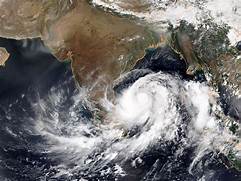Published on: October 10, 2021

CYCLONES & ECONOMY OF INDIA
CYCLONES & ECONOMY OF INDIA

What are cyclones : A cyclone is defined as a powerful storm containing strong winds and rains. It is formed when the warm and moist air rises making space for cool air in low-pressure areas.
CYCLONES IN INDIA
- The severe cyclones, Tauktae and Yaas, which battered India earlier this year, made landfalls on the country’s western coast, Gujarat, and the eastern coast, Odisha, on May 17 and May 26, 2021, respectively. Both storms caused massive damage to infrastructure, the agricultural sector, and houses.
- Increasing sea surface temperatures in the northern Indian Ocean and the geo-climatic conditions in India have led to a rise in the frequency of devastating cyclones in the coastal States accounting for 7% of the global tropical cyclones, according to India Meteorological Department (IMD), 2013 data.
- Every year, around five to six tropical cyclones are formed in the Bay of Bengal and the Arabian Sea; of these, two to three turn severe.
- The Indian coastline is around 7,500 km; there are 96 coastal districts (which touch the coast or are close to it), with 262 million people exposed to cyclones and tsunamis. The World Bank and the United Nations (2010) estimate that around 200 million city residents would be exposed to storms and earthquakes by 2050 in India.
ECONOMIC DAMAGE CAUSED BY CYCLONES
- Among the natural disasters, cyclones constituted the second most frequent phenomena that occurred in 15% of India’s total natural disasters over 1999-2020.
- During the same period, 12,388 people were killed, and the damage was estimated at $32,615 million.
- Cyclones are the second most expensive in terms of the costs incurred in damage, accounting for 29% of the total disaster-related damages after floods (62%).
- In addition, they are the third most lethal disaster in India after earthquakes (42%) and floods (33%). However, fatalities due to cyclones declined from 10,378 in 1999 to 110 in 2020; the significant drop was on account of improved early warning systems, cyclone forecasting, and better disaster management activities such as timely evacuation, rehabilitation and relief distributions.
- But these measures are not adequate to achieve a zero-fatality approach and minimise economic losses from cyclones.
- Between 1999 and 2020, cyclones inflicted substantial damage to public and private properties, amounting to an increase in losses from $2,990 million to $14,920 million in the absence of long-term mitigation measures. In addition, damages caused due to cyclones increased nine times during the same period.
- As a result, direct government expenditure on natural calamities increased 13 times. The Asian Development Bank’s report in 2014 estimated that India would suffer a loss of around 1.8% of GDP annually by 2050 from climate-related events.
- India lost around 2% of GDP and 15% of total revenue over 1999-2020. According to the Global Climate Risk Index report 2021, India ranks the seventh worst-hit country globally in 2019 due to the frequent occurrence of extreme weather-related events. Moreover, the report showed that India lost around 2,267 human lives, while damages stood at $68,812 million in Purchasing Power Parity (PPP) terms in 2019. In the same year, India ranked first concerning human deaths and economic losses due to extreme weather-related events
WAY FORWARD
- Improve the cyclone warning system and revamp disaster preparedness measures.
- Government must widen the cover under shelterbelt plantations and help regenerate mangroves in coastal regions to lessen the impact of cyclones.
- Adopting cost-effective, long-term mitigation measures, including building cyclone-resilient infrastructure such as constructing storm surge-resilient embankments, canals and improving river connectivity to prevent waterlogging in low-lying areas are important.
- Installing disaster-resilient power infrastructure in the coastal districts, providing concrete houses to poor and vulnerable households, and creating massive community awareness campaigns are essential.
- Healthy coordination between the Centre and the States concerned is essential to collectively design disaster mitigation measures. It is only such a collective mitigation effort by the Centre and States that can help reduce the fiscal burden of States and also be effective in minimising disaster deaths.

